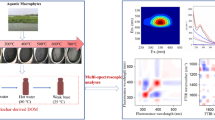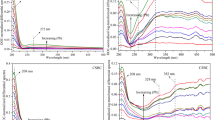Abstract
Differential absorbance spectroscopy (DAS) was used in this study as an in situ approach to characterize the functional groups in natural organic matters (NOMs) with respect to their conformational change at varying pHs and interactions with metal ions. Suwannee River fulvic acid (SRFA) was profiled by DAS as the feature bands of phenolic groups evolved at wavelengths of 244 nm and 330–380 nm and a peak signifying carboxylic groups at 280 nm. Water treatment process (e.g., chlorination) altered the properties of functional groups, as could be reflected by DAS profiles. Furthermore, NOM-calcium interactions were investigated using nonideal competitive adsorption (NICA) model to describe the specific binding of calcium ions to NOMs. Correlations between the observed changes in the intensity of the representative DAS features as well as spectral slopes of NOM showed that these parameters were strongly correlated with the amount of NOM-bound calcium. The result suggested that the NICA-Donnan model could be expanded to reflect and predict the true diversity of NOM groups engaged in interactions with metal cations in biogeochemical and engineering systems.
Access provided by Autonomous University of Puebla. Download conference paper PDF
Similar content being viewed by others
Keywords
Introduction
Natural organic matter (NOM) is one of the most important components in natural and engineered environmental systems. Multiple physical and chemical processes, such as the transport and toxicity of heavy metals and the formation of disinfection by-products (DBPs), are strongly impacted by NOMs. NOM functionalities, primarily carboxylic and phenolic groups, play a key role in the interactions between NOM and, on the other hand, metals and halogens (Leenheer et al. 1995). Therefore, it is of importance to further characterize these functional groups as well as their behavior with diverse environmental reactions.
The heterogeneity of NOM chemistry makes it difficult to measure its properties (e.g., molecular weight, proton affinity) precisely and especially in situ. NOM fractionation according to size or hydrophobicity has made a great contribution to the understanding of NOM characterization, but the alternation of the sample via its preconcentration, filtration, and other procedures could potentially change NOM properties. Differential absorbance spectroscopy (DAS) represents an alternative in situ approach to describe the deprotonation of NOM chromophores, which are closely related to or indeed are identical with the functional groups and are associated with conformational changes in NOM molecules. The merits of this methods are that (a) no pretreatment or preconcentration is required for water sample with any NOM levels, (b) extremely subtle changes in NOM chromophores can be precisely measured, (c) differential absorbance spectra are often feature rich, (d) interactions of NOM with different species (e.g., proton, metal ions, halogens) can be probed, and (e) DAS data can be interpreted based on existing NOM protonation and metal complexation theories. In this study, we applied this method to probe interaction of NOM and calcium, one of the most abundant and important components of any environmental system.
Materials and Methods
Commercially available NOM samples, including standard Suwannee River fulvic acid (SRFA) from International Humic Substance Society (IHSS) and Aldrich humic acid, were used as model compounds for the study of chromophore behavior under different pHs and at varying metal concentration. Chlorination, ozonation, and coagulation were applied to alter these NOMs to study the change in functional groups under different water treatments. In addition, NOM from natural water body (e.g., Lake Washington) was studied to provide insights to the real system. Absorbance spectra were measured by a PerkinElmer Lambda 18 UV/Vis spectrophotometer, and details of this method were described by Dryer et al. (2008). High-performance size-exclusion chromatography (HPSEC) was carried out to investigate changes of apparent molecular weight (AMW) and quantify size changes indicated by DAS data features.
Results and Discussion
Differential absorbance spectra are calculated as where l (cell) is the cell length (in cm) and DOC is the dissolved organic carbon concentration in the sample (mg/L). In this formula, ApH (λ) is the absorbance measured at any wavelength at varying pHs, while ApHref (λ) is the reference absorbance usually measured at a low-enough pH at which NOM functional groups are practically completely protonated. DAS profiles reflect the contributions of NOM functional group in featuring the evolution of several characteristic peaks or bands that develop as the pH increases from its reference level. We have determined that the engagement of NOM phenolic groups results in a broad band located around 330–380 nm and a peak at about 244 nm as well. As shown on Fig. 1a, this feature becomes especially prominent when pH was raised above 7.6. This is consistent with the fact that the pKa’s for phenolic groups are in the range of 7.2–10.9 (Milne et al. 2001). On the other hand, the deprotonation of carboxylic groups results in a DAS feature peaking at 280 nm; this feature is significant at lower pHs since the pKa for carboxylic group ranges from 2 to 3.8. Figure 1a–c indicates that the oxidation of NOMs (e.g., by chlorination or ozonation) results in suppression of the response of the phenolic groups. The phenolic feature mentioned above (e.g., the feature located at 244-nm and 330–380-nm band) diminishes and finally practically disappears when the chlorine dose was doubled as the NOM concentration, indicating the phenolic groups were more readily attacked by chlorine than carboxylic group.
The behavior of the DAS features can be interpreted with nonideal competitive adsorption (NICA) model. In the model, protons bind to sites including carboxylic groups (FA1) and phenolic groups (FA2). The pH differential DAS profiles can be calculated within this model, where AFA1(λ) and AFA2(λ) are the maximum change of the absorbance associated with the deprotonation of the carboxylic and phenolic groups, respectively. KFA1 and KFA2 are proton affinity distributions for these groups, and hFA1 and hFA2 are the apparent heterogeneity of the NOM protonation sites. By fitting the experimental data to the modeling, contribution of the two functional groups in binding with proton or cations can be elucidated.
The evolution of DAS spectra of NOM at varying calcium concentrations provided a clear and specific dataset as Fig. 2 shows the development of several pronounced DAS peaks located at wavelength of 250, 320, and 390 nm. This was caused by the binding of calcium with NOM chromophores (primarily functional groups) and also the conformational changes within the NOM molecules. The DAS features that emerged as a result of its interactions with calcium were somewhat different from those resulting from the deprotonation of NOM molecules (e.g., in Fig. 1a), which may due to the different aspects of the behavior of metals and protons in binding with NOMs as well as changes of NOM conformations resulting from these interactions.
NICA model was used to interpret the specific binding of calcium ions to NOM. In the model, calcium was assumed to bind to the carboxylic groups (FA1), phenolic groups (FA2), and also via electrostatic interactions (Donnan gel). Correlations between the observed changes in the intensity of the representative DAS features as well as spectral slopes of NOM showed that these parameters were strongly correlated with the amount of NOM-bound calcium (Fig. 3). These data also indicate that the generic NOM-Ca binding parameters used in the NICA database may need to be adjusted to achieve better convergence with the experimental data. Alternatively, the NICA-Donnan approach may be expanded to reflect the true diversity of NOM groups engaged in interactions with calcium and other metal cations.
References
Dryer, D.J., G.V. Korshin, and M. Fabbricino. 2008. In situ examination of the protonation behavior of fulvic acids using differential absorbance spectroscopy. Environmental Science and Technology 42(17): 6644–6649.
Leenheer, J.A., R.L. Wershaw, and M.M. Reddy. 1995. Strong-acid carboxyl-group structures in fulvic acid from the Suwannee River, Georgia. 2. Major structures. Environmental Science and Technology 29: 399–405.
Milne, C.J., D.G. Kinniburgh, and E. Tipping. 2001. Generic NICA-Donnan model parameters for proton binding by humic substances. Environmental Science and Technology 35(10): 2049–2059.
Author information
Authors and Affiliations
Corresponding author
Editor information
Editors and Affiliations
Rights and permissions
Copyright information
© 2013 Zhejiang University Press and Springer Science+Business Media Dordrecht
About this paper
Cite this paper
Gao, Y., Korshin, G.V. (2013). An Innovative In Situ Spectroscopic Approach to Characterize Functional Groups in Natural Organic Matters (NOMs) and Their Interactions with Protons and Metals. In: Xu, J., Wu, J., He, Y. (eds) Functions of Natural Organic Matter in Changing Environment. Springer, Dordrecht. https://doi.org/10.1007/978-94-007-5634-2_32
Download citation
DOI: https://doi.org/10.1007/978-94-007-5634-2_32
Published:
Publisher Name: Springer, Dordrecht
Print ISBN: 978-94-007-5633-5
Online ISBN: 978-94-007-5634-2
eBook Packages: Earth and Environmental ScienceEarth and Environmental Science (R0)







